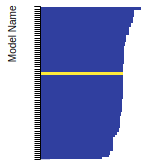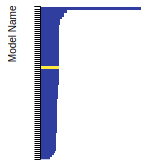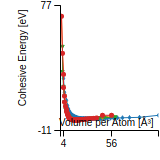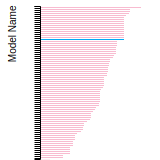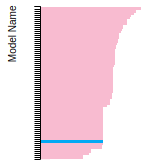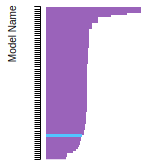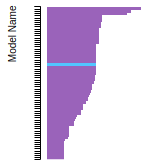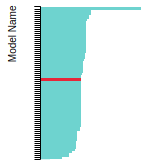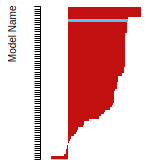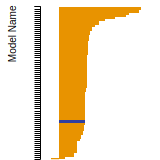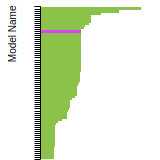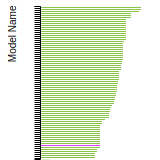 MEAM_LAMMPS_LeeLee_2010_FeAl__MO_332211522050_002
MEAM_LAMMPS_LeeLee_2010_FeAl__MO_332211522050_002
| Title
A single sentence description.
|
MEAM Potential for the Fe-Al system developed by Lee, and Lee. (2010) v002 |
|---|---|
| Description
A short description of the Model describing its key features including for example: type of model (pair potential, 3-body potential, EAM, etc.), modeled species (Ac, Ag, ..., Zr), intended purpose, origin, and so on.
|
The potential can describe various fundamental physical properties of Fe–Al binary alloys—structural, elastic and thermodynamic properties, defect formation behavior and interactions between defects—in reasonable agreement with experimental data or higher-level calculations. In the original paper (Lee and Lee, J. Phys. Condens. Matter., 22, 2010) The applicability of the potential to atomistic investigations of various defect formation behaviors and their effects on the mechanical properties of high aluminum steels as well as Fe–Al binary alloys is demonstrated. |
| Species
The supported atomic species.
| Al, Fe |
| Disclaimer
A statement of applicability provided by the contributor, informing users of the intended use of this KIM Item.
|
None |
| Content Origin | http://cmse.postech.ac.kr/home_2nnmeam |
| Contributor |
Hyeon-Seok Do |
| Maintainer |
Hyeon-Seok Do |
| Developer |
Eunkoo Lee Byeong-Joo Lee |
| Published on KIM | 2023 |
| How to Cite |
This Model originally published in [1] is archived in OpenKIM [2-5]. [1] Lee E, Lee B-J. Modified embedded-atom method interatomic potential for the Fe–Al system. Journal of Physics: Condensed Matter. 2010;22(17):175702. doi:10.1088/0953-8984/22/17/175702 — (Primary Source) A primary source is a reference directly related to the item documenting its development, as opposed to other sources that are provided as background information. [2] Lee E, Lee B-J. MEAM Potential for the Fe-Al system developed by Lee, and Lee. (2010) v002. OpenKIM; 2023. doi:10.25950/5eebb923 [3] Afshar Y, Hütter S, Rudd RE, Stukowski A, Tipton WW, Trinkle DR, et al. The modified embedded atom method (MEAM) potential v002. OpenKIM; 2023. doi:10.25950/ee5eba52 [4] Tadmor EB, Elliott RS, Sethna JP, Miller RE, Becker CA. The potential of atomistic simulations and the Knowledgebase of Interatomic Models. JOM. 2011;63(7):17. doi:10.1007/s11837-011-0102-6 [5] Elliott RS, Tadmor EB. Knowledgebase of Interatomic Models (KIM) Application Programming Interface (API). OpenKIM; 2011. doi:10.25950/ff8f563a Click here to download the above citation in BibTeX format. |
| Citations
This panel presents information regarding the papers that have cited the interatomic potential (IP) whose page you are on. The OpenKIM machine learning based Deep Citation framework is used to determine whether the citing article actually used the IP in computations (denoted by "USED") or only provides it as a background citation (denoted by "NOT USED"). For more details on Deep Citation and how to work with this panel, click the documentation link at the top of the panel. The word cloud to the right is generated from the abstracts of IP principle source(s) (given below in "How to Cite") and the citing articles that were determined to have used the IP in order to provide users with a quick sense of the types of physical phenomena to which this IP is applied. The bar chart shows the number of articles that cited the IP per year. Each bar is divided into green (articles that USED the IP) and blue (articles that did NOT USE the IP). Users are encouraged to correct Deep Citation errors in determination by clicking the speech icon next to a citing article and providing updated information. This will be integrated into the next Deep Citation learning cycle, which occurs on a regular basis. OpenKIM acknowledges the support of the Allen Institute for AI through the Semantic Scholar project for providing citation information and full text of articles when available, which are used to train the Deep Citation ML algorithm. |
This panel provides information on past usage of this interatomic potential (IP) powered by the OpenKIM Deep Citation framework. The word cloud indicates typical applications of the potential. The bar chart shows citations per year of this IP (bars are divided into articles that used the IP (green) and those that did not (blue)). The complete list of articles that cited this IP is provided below along with the Deep Citation determination on usage. See the Deep Citation documentation for more information. 
99 Citations (61 used)
Help us to determine which of the papers that cite this potential actually used it to perform calculations. If you know, click the .
USED (high confidence) Q. Li, C. Jiang, and Y. Du, “Molecular-Dynamics Study on the Impact Energy Release Characteristics of Fe–Al Energetic Jets,” Materials. 2021. link Times cited: 0 Abstract: Fe–Al energetic material releases a large amount of energy u… read more USED (high confidence) N. V. Tuyen, H. Hieu, N. Duc, T. T. Hai, N. T. Hong, and T. Ha, “Pressure effects on thermo-mechanical properties of intermetallic B2-type FeAl alloy,” The European Physical Journal B. 2020. link Times cited: 3 USED (high confidence) J. Wang et al., “Greater diffusion rate of carbon atoms from nonlinear migration in micro-cell and spatially heterogeneous stable states in FCC iron,” Journal of Materials Science. 2018. link Times cited: 2 USED (high confidence) F. Ulomek and V. Mohles, “Molecular dynamics simulations of grain boundary mobility in Al, Cu and γ-Fe using a symmetrical driving force,” Modelling and Simulation in Materials Science and Engineering. 2014. link Times cited: 13 Abstract: We present a new artificial driving force for the determinat… read more USED (high confidence) J. Shim, W. Ko, J.-Y. Suh, Y.-S. Lee, and B.-J. Lee, “Atomistic simulation of hydrogen diffusion at tilt grain boundaries in vanadium,” Metals and Materials International. 2013. link Times cited: 8 USED (high confidence) W. Ko, J. Shim, and B.-J. Lee, “Atomistic modeling of the Al–H and Ni–H systems,” Journal of Materials Research. 2011. link Times cited: 15 Abstract: Second nearest-neighbor modified embedded-atom method (MEAM)… read more USED (low confidence) S. Hayakawa and H. Xu, “Development of an interatomic potential for L12 precipitates in Fe–Ni–Al alloys,” Computational Materials Science. 2024. link Times cited: 0 USED (low confidence) Z. Wang, Y. Li, B. Xu, and H. Yang, “Calculation of formation enthalpies for Alfcc-Xbcc (X=Cr, Fe, Mo, Ta, V and W) binary alloys with MAEAM,” Physica B: Condensed Matter. 2023. link Times cited: 0 USED (low confidence) M. Muralles, J. T. Oh, and Z. Chen, “Modified embedded atom method interatomic potentials for the Fe-Al, Fe-Cu, Fe-Nb, Fe-W, and Co-Nb binary alloys,” Computational Materials Science. 2023. link Times cited: 0 USED (low confidence) X. Li, R. Zhang, Z. Liu, and Y. Pu, “Molecular Dynamics Study on Friction of the Iron-Aluminum Alloy,” SSRN Electronic Journal. 2022. link Times cited: 5 USED (low confidence) K. Chen, S. Mun, M. Baskes, M. Horstemeyer, and B. Li, “Development of 2NN MEAM potential for Fe–Al and atomistic investigation of surface and interface properties of the inhibition layer in galvanized Fe,” Modelling and Simulation in Materials Science and Engineering. 2022. link Times cited: 2 Abstract: Hot-dip Zn coating or galvanizing is an important process fo… read more USED (low confidence) M. Wu et al., “Research on the Lattice Matching of Different Solute Atoms in BCC Fe: A Molecular Dynamics Simulation,” Crystal Research and Technology. 2022. link Times cited: 0 Abstract: In this article, molecular dynamics simulation is used to pr… read more USED (low confidence) A. Mahata, T. Mukhopadhyay, and M. A. Zaeem, “Modified embedded-atom method interatomic potentials for Al-Cu, Al-Fe and Al-Ni binary alloys: From room temperature to melting point,” Computational Materials Science. 2022. link Times cited: 27 USED (low confidence) J. Syarif, K. Badawy, and H. Hussien, “Atomistic simulation of the diffusion behavior in Al-Fe,” Nuclear Materials and Energy. 2021. link Times cited: 2 USED (low confidence) S.-wei Liu, Y. Lin, L. Han, X. Wang, G. Zhao, and G. Wang, “Atomistic simulation of microstructure evolution of NiTi single crystals in bending deformation,” Computational Materials Science. 2021. link Times cited: 8 USED (low confidence) M. Khalid, J. Friis, P. H. Ninive, K. Marthinsen, I. G. Ringdalen, and A. Strandlie, “Modified embedded atom method potential for Fe-Al intermetallics mechanical strength: A comparative analysis of atomistic simulations,” Physica B-condensed Matter. 2021. link Times cited: 4 USED (low confidence) F. Hadef and M. Ans, “X-ray analysis and Rietveld refinement of ball milled Fe50Al35Ni15 powder,” Surfaces and Interfaces. 2021. link Times cited: 7 USED (low confidence) T. Li, D. Zhou, Y. Yan, P. Peng, and J. Liu, “First-principles and experimental investigations on ductility/brittleness of intermetallic compounds and joint properties in steel/aluminum laser welding,” Transactions of Nonferrous Metals Society of China. 2021. link Times cited: 11 USED (low confidence) C.-he Jiang, K. Li, J. Zhang, M. Sun, and Z. Bi, “Structural characteristics of liquid iron with various carbon contents based on atomic simulation,” Journal of Molecular Liquids. 2021. link Times cited: 3 USED (low confidence) A. Agrawal and R. Mirzaeifar, “Copper-graphene composites; developing the MEAM potential and investigating their mechanical properties,” Computational Materials Science. 2021. link Times cited: 9 USED (low confidence) X. Liao et al., “Interatomic potentials and defect properties of Fe–Cr–Al alloys,” Journal of Nuclear Materials. 2020. link Times cited: 12 USED (low confidence) Q. Kang et al., “An investigation of hydrogen embrittlement of 12Cr2Mo1R(H) steel by slow strain rate tests and first-principles calculation,” Anti-corrosion Methods and Materials. 2020. link Times cited: 0 Abstract:
Purpose
With excellent mechanic properties and hydrogen emb… read more USED (low confidence) J. Ju et al., “First-principles investigations of the stability, electronic structures, mechanical properties and thermodynamic properties of FexAlyCz compounds in Fe-Cr-B-Al-C alloy,” Journal of Physics and Chemistry of Solids. 2020. link Times cited: 12 USED (low confidence) D. An, W. Krieger, and S. Zaefferer, “Unravelling the effect of hydrogen on microstructure evolution under low-cycle fatigue in a high-manganese austenitic TWIP steel,” International Journal of Plasticity. 2020. link Times cited: 22 USED (low confidence) H.-S. Jang, D. Seol, and B.-J. Lee, “Modified embedded-atom method interatomic potential for the Mg–Zn–Ca ternary system,” Calphad-computer Coupling of Phase Diagrams and Thermochemistry. 2019. link Times cited: 6 USED (low confidence) S. Ding and X.-qiang Wang, “A systematic study on the MEAM interatomic potentials of the transition metal nitrides TMNs (TM=Ti, V, Cr, Fe) binary systems,” Journal of Alloys and Compounds. 2019. link Times cited: 10 USED (low confidence) Y. Cheng et al., “Dynamic and structural heterogeneity in undercooled miscible and immiscible metallic liquid,” Journal of Alloys and Compounds. 2019. link Times cited: 4 USED (low confidence) K. Wang et al., “Mechanical Properties, Electronic Structures, and Debye Temperature of NixBy Compounds Obtained by the First Principles Calculations,” Crystals. 2018. link Times cited: 11 Abstract: Mechanical properties, electronic properties, and Debye temp… read more USED (low confidence) T. Lu et al., “Atomistic study of hydrogen behavior around dislocations in α iron,” Journal of Nuclear Materials. 2018. link Times cited: 18 USED (low confidence) W. Ko and J. Jeon, “Atomistic simulations of PdTi high-temperature shape-memory alloys,” Intermetallics. 2018. link Times cited: 2 USED (low confidence) X. He, Q. Bai, and R. Shen, “Atomistic perspective of how graphene protects metal substrate from surface damage in rough contacts,” Carbon. 2018. link Times cited: 40 USED (low confidence) P. Srinivasan, L. Nicola, and A. Simone, “Modeling pseudo-elasticity in NiTi: Why the MEAM potential outperforms the EAM-FS potential,” Computational Materials Science. 2017. link Times cited: 23 USED (low confidence) C.-jun Wu, B.-J. Lee, and X. Su, “Modified embedded-atom interatomic potential for Fe-Ni, Cr-Ni and Fe-Cr-Ni systems,” Calphad-computer Coupling of Phase Diagrams and Thermochemistry. 2017. link Times cited: 60 USED (low confidence) Y. Ueno et al., “Study of Defects Introduced by 2 and 9 MeV Electron Irradiation in B2 Type Fe-Al Alloy,” Defect and Diffusion Forum. 2017. link Times cited: 0 Abstract: It is well known that intermetallic compound alloys possibly… read more USED (low confidence) A. Al-Motasem, J. Bergström, A. Gåård, P. Krakhmalev, and L. J. Holleboom, “Tool microstructure impact on the wear behavior of ferrite iron during nanoscratching: An atomic level simulation,” Wear. 2017. link Times cited: 14 USED (low confidence) A. Al-Motasem, A. Al-Motasem, J. Bergström, A. Gåård, P. Krakhmalev, and L. J. Holleboom, “Adhesion between ferrite iron–iron/cementite countersurfaces: A molecular dynamics study,” Tribology International. 2016. link Times cited: 8 USED (low confidence) X. Liu et al., “Mössbauer Spectroscopy of Iron Carbides: From Prediction to Experimental Confirmation,” Scientific Reports. 2016. link Times cited: 89 USED (low confidence) L. Liu, X. Wu, R. Wang, W. Li, and Q. Liu, “First principle study on the temperature dependent elastic constants, anisotropy, generalized stacking fault energy and dislocation core of NiAl and FeAl ☆,” Computational Materials Science. 2015. link Times cited: 40 USED (low confidence) C. Zhang, S. Huang, J. Shen, and N. Chen, “Structural and mechanical properties of Fe–Al compounds: An atomistic study by EAM simulation,” Intermetallics. 2014. link Times cited: 43 USED (low confidence) T. A. Timmerscheidt, J. Appen, and R. Dronskowski, “A molecular-dynamics study on carbon diffusion in face-centered cubic iron,” Computational Materials Science. 2014. link Times cited: 14 USED (low confidence) F. Ye, C. Yin, K. Tong, C. Zhang, and W. Liu, “Structural evolution of vacancy clusters by combination of cluster units in alpha-iron,” Materials Research Innovations. 2014. link Times cited: 0 Abstract: The development of vacancy clusters in α-Fe is essential for… read more USED (low confidence) J. Shim et al., “Prediction of hydrogen permeability in V–Al and V–Ni alloys,” Journal of Membrane Science. 2013. link Times cited: 21 USED (low confidence) Y. Ouyang et al., “Thermodynamic and physical properties of FeAl and Fe3Al: an atomistic study by EAM simulation,” Physica B-condensed Matter. 2012. link Times cited: 31 USED (low confidence) P. Rivera-Díaz-del-Castillo, “Rolling Contact Fatigue in Bearings: Phenomenology and Modelling Techniques.” 2012. link Times cited: 3 Abstract: Current understanding of rolling contact fatigue is reviewed… read more USED (low confidence) Y.-S. Chun, J. Lee, C. Bae, K.-T. Park, and C. Lee, “Caliber-rolled TWIP steel for high-strength wire rods with enhanced hydrogen-delayed fracture resistance,” Scripta Materialia. 2012. link Times cited: 49 USED (low confidence) W. Ko, J. Jeon, J. Shim, and B.-J. Lee, “Origin of hydrogen embrittlement in vanadium-based hydrogen separation membranes,” International Journal of Hydrogen Energy. 2012. link Times cited: 24 USED (low confidence) K. Kim, J. Shim, and B.-J. Lee, “Effect of alloying elements (Al, Co, Fe, Ni) on the solubility of hydrogen in vanadium: A thermodynamic calculation,” International Journal of Hydrogen Energy. 2012. link Times cited: 24 USED (low confidence) Y.-S. Chun, J. S. Kim, K.-T. Park, Y. K. Lee, and C. Lee, “Role of ɛ martensite in tensile properties and hydrogen degradation of high-Mn steels,” Materials Science and Engineering A-structural Materials Properties Microstructure and Processing. 2012. link Times cited: 87 USED (low confidence) H. Kimizuka and S. Ogata, “Slow diffusion of hydrogen at a screw dislocation core in α-iron,” Physical Review B. 2011. link Times cited: 44 Abstract: Here we demonstrate and characterize the H-diffusion behavio… read more USED (low confidence) B. Jelinek et al., “Modified embedded atom method potential for Al, Si, Mg, Cu, and Fe alloys,” Physical Review B. 2011. link Times cited: 218 Abstract: A set of modified embedded-atom method (MEAM) potentials for… read more USED (low confidence) H. Kimizuka, H. Mori, and S. Ogata, “Effect of temperature on fast hydrogen diffusion in iron: A path-integral quantum dynamics approach,” Physical Review B. 2011. link Times cited: 45 USED (low confidence) B.-J. Lee, W. Ko, H.-K. Kim, and E.-H. Kim, “The modified embedded-atom method interatomic potentials and recent progress in atomistic simulations,” Calphad-computer Coupling of Phase Diagrams and Thermochemistry. 2010. link Times cited: 137 USED (low confidence) Y.-M. Kim, N. Kim, and B.-J. Lee, “Atomistic Modeling of pure Mg and Mg―Al systems,” Calphad-computer Coupling of Phase Diagrams and Thermochemistry. 2009. link Times cited: 119 USED (low confidence) S. Cusenza and P. Schaaf, “Formation and characterization of NaCl-type FeC,” Materials Letters. 2009. link Times cited: 10 USED (low confidence) H.-K. Kim, W. Jung, and B.-J. Lee, “Modified embedded-atom method interatomic potentials for the Fe–Ti–C and Fe–Ti–N ternary systems,” Acta Materialia. 2008. link Times cited: 121 USED (low confidence) Y. Zhang, W. Wang, Z. Li, G. Huang, H. Zhang, and F. Liu, “Study of the brittleness mechanism of aluminum/steel laser welded joints with copper and vanadium interlayers,” Optics & Laser Technology. 2023. link Times cited: 2 USED (low confidence) B. C. Cooman, Y. Estrin, and S.-kyu Kim, “Twinning-induced plasticity (TWIP) steels,” Acta Materialia. 2018. link Times cited: 874 USED (low confidence) B. D. Cooman, “High Mn TWIP steel and medium Mn steel.” 2017. link Times cited: 43 USED (low confidence) R. Jones, C. Weinberger, S. Coleman, and G. Tucker, “Introduction to Atomistic Simulation Methods.” 2016. link Times cited: 1 USED (low confidence) P. Castaño-Rivera, N. D. Vincentis, R. Bolmaro, and P. Bruzzoni, “Relationship between Dislocation Densityand Hydrogen Trappingin a Cold Worked API 5L X60 Steel,” Procedia Materials Science. 2015. link Times cited: 10 USED (low confidence) Y.-M. Kim, Y.-H. Shin, and B.-J. Lee, “Modified embedded-atom method interatomic potentials for pure Mn and the Fe–Mn system,” Acta Materialia. 2009. link Times cited: 64 NOT USED (low confidence) “Revealing the Epitaxial Interface between Al13Fe4 and Al5Fe2 Enabling Atomic Al Interdiffusion.,” ACS applied materials & interfaces. 2023. link Times cited: 1 Abstract: Steel is the most commonly manufactured material in the worl… read more NOT USED (low confidence) A. Ameur et al., “First principles investigations of the structural, electronic, mechanical, linear and nonlinear optical properties of RbIO2F2,” Physica B: Condensed Matter. 2022. link Times cited: 0 NOT USED (low confidence) B. Narayanan et al., “Development of a Modified Embedded Atom Force Field for Zirconium Nitride Using Multi-Objective Evolutionary Optimization,” Journal of Physical Chemistry C. 2016. link Times cited: 23 Abstract: Zirconium nitride (ZrN) exhibits exceptional mechanical, che… read more NOT USED (low confidence) M. Tschopp, K. Solanki, M. Baskes, F. Gao, X. Sun, and M. Horstemeyer, “Generalized framework for interatomic potential design: Application to Fe–He system,” Journal of Nuclear Materials. 2012. link Times cited: 20 NOT USED (low confidence) E. Tadmor and R. E. Miller, “Modeling Materials: Continuum, Atomistic and Multiscale Techniques.” 2011. link Times cited: 395 Abstract: 1. Introduction Part I. Continuum Mechanics and Thermodynami… read more NOT USED (low confidence) С. Волегов, Р. М. Герасимов, and Р. П. Давлятшин, “MODELS OF MOLECULAR DYNAMICS: A REVIEW OF EAM-POTENTIALS. PART 2. POTENTIALS FOR MULTI-COMPONENT SYSTEMS.” 2018. link Times cited: 1 Abstract: Получена: 18 мая 2018 г. Принята: 25 июня 2018 г. Опубликова… read more NOT USED (low confidence) 肇 君塚, 英喜 森, 裕己 牛田, and 成信 尾方, “経路積分セントロイド分子動力学法による BCC 金属中の水素拡散性とその温度依存性の評価,” Journal of The Japan Institute of Metals. 2009. link Times cited: 5 Abstract: We have analyzed the diffusion behavior of interstitial hydr… read more NOT USED (high confidence) J. Wang, H. Kwon, H. S. Kim, and B. Lee, “A neural network model for high entropy alloy design,” npj Computational Materials. 2023. link Times cited: 1 NOT USED (high confidence) J.-yu Yang, Y. Zhang, Y. Liu, W. Hu, and X. Dai, “A comparative atomic simulation study of the configurations in M-Al (M = Mg, Ni, and Fe) nanoalloys: influence of alloying ability, surface energy, atomic radius, and atomic arrangement,” Journal of Nanoparticle Research. 2020. link Times cited: 3 NOT USED (high confidence) T. Funabashi, Y. Kobayashi, and Y. Yamada, “Metastable iron carbide thin films produced by pulsed laser deposition of iron in methane atmosphere,” Hyperfine Interactions. 2019. link Times cited: 8 NOT USED (high confidence) D. Dickel, C. Barrett, R. Cariño, M. Baskes, and M. Horstemeyer, “Mechanical instabilities in the modeling of phase transitions of titanium,” Modelling and Simulation in Materials Science and Engineering. 2018. link Times cited: 16 Abstract: In this paper, we demonstrate that previously observed β to … read more NOT USED (high confidence) T. Prasanthi, C. Sudha, and S. Saroja, “Molecular Dynamics Simulation of Diffusion of Fe in HCP Ti Lattice,” Transactions of the Indian Institute of Metals. 2018. link Times cited: 2 NOT USED (high confidence) S. Liu et al., “Refinement effect of TiC on ferrite by molecular statics/dynamics simulations and first-principles calculations,” Journal of Alloys and Compounds. 2018. link Times cited: 3 NOT USED (high confidence) P. Kuopanportti, E. Hayward, C. Fu, A. Kuronen, and K. Nordlund, “Interatomic FeH potential for irradiation and embrittlement simulations,” Computational Materials Science. 2016. link Times cited: 18 NOT USED (high confidence) J. Janssen, N. Gunkelmann, and H. Urbassek, “Influence of C concentration on elastic moduli of α′-Fe1-xCx alloys,” Philosophical Magazine. 2016. link Times cited: 9 Abstract: The elastic constants of tetragonally distorted - crystallit… read more NOT USED (high confidence) M. M. Islam, C. Zou, A. V. van Duin, and S. Raman, “Interactions of hydrogen with the iron and iron carbide interfaces: a ReaxFF molecular dynamics study.,” Physical chemistry chemical physics : PCCP. 2016. link Times cited: 44 Abstract: Hydrogen embrittlement (HE) is a well-known material phenome… read more NOT USED (high confidence) C. P. Chui, W. Liu, Y. Xu, and Y. Zhou, “Molecular Dynamics Simulation of Iron — A Review.” 2015. link Times cited: 3 Abstract: Molecular dynamics (MD) is a technique of atomistic simulati… read more NOT USED (high confidence) W. Dong, B.-J. Lee, and Z. Chen, “Atomistic modeling for interfacial properties of Ni-Al-V ternary system,” Metals and Materials International. 2014. link Times cited: 6 NOT USED (high confidence) B.-M. Lee and B.-J. Lee, “A Comparative Study on Hydrogen Diffusion in Amorphous and Crystalline Metals Using a Molecular Dynamics Simulation,” Metallurgical and Materials Transactions A. 2014. link Times cited: 35 NOT USED (high confidence) K. Henriksson, C. Björkas, and K. Nordlund, “Atomistic simulations of stainless steels: a many-body potential for the Fe–Cr–C system,” Journal of Physics: Condensed Matter. 2013. link Times cited: 65 Abstract: Stainless steels found in real-world applications usually ha… read more NOT USED (high confidence) O. Verners, Y. Shin, and A. Duin, “Molecular dynamics simulation of Al grain mixing in Fe/Ni matrices and its influence on oxidation,” Journal of Applied Physics. 2013. link Times cited: 1 Abstract: AlxNiyFe(1−x−y) alloys are structural materials with potenti… read more NOT USED (high confidence) T. Ito, T. Arima, M. Himi, and H. Yugo, “Atomistic simulations on the interfacial interaction of metallic fuel and structural materials in SFRs - molecular dynamics model for Pu-Fe system,” Journal of Nuclear Science and Technology. 2013. link Times cited: 2 Abstract: Interaction between metallic fuel and steel structures is on… read more NOT USED (high confidence) S. Wang, K. Takahashi, N. Hashimoto, S. Isobe, and S. Ohnuki, “Strain field of interstitial hydrogen atom in body-centered cubic iron and its effect on hydrogen–dislocation interaction,” Scripta Materialia. 2013. link Times cited: 21 NOT USED (high confidence) R. Karnesky, N. Bartelt, N. Teslich, and M. Kumar, “Imaging and quantification of hydrogen isotope trapping.” 2012. link Times cited: 7 Abstract: The location of hydrogen isotopes is imaged in austenitic st… read more NOT USED (high confidence) J. Kang, B. Hosseinkhani, and P. Rivera-Diaz-Del-Castillo, “Rolling contact fatigue in bearings: multiscale overview,” Materials Science and Technology. 2012. link Times cited: 77 Abstract: For over a century, rolling contact fatigue in bearings has … read more NOT USED (high confidence) B.-M. Lee and B.-J. Lee, “Probing the hydrogen movement in Zr-Cu amorphous alloys using molecular dynamics simulations,” 2011 IEEE Nanotechnology Materials and Devices Conference. 2011. link Times cited: 0 Abstract: Zr-based amorphous alloys, showing hydrogen permeance compar… read more NOT USED (high confidence) H.-K. Kim, W. Jung, and B.-J. Lee, “Modified embedded-atom method interatomic potentials for the Nb-C, Nb-N, Fe-Nb-C, and Fe-Nb-N systems,” Journal of Materials Research. 2010. link Times cited: 21 Abstract: Modified embedded-atom method (MEAM) interatomic potentials … read more NOT USED (high confidence) X. Tan, J. Zhou, F. Liu, Y. Peng, and B. Zhao, “Structural and electronic properties of carbon adsorbed on Fe(100),” The European Physical Journal B. 2010. link Times cited: 8 NOT USED (high confidence) A. Duff and M. Sluiter, “Diagnostic Structures for Interatomic Potentials,” Materials Transactions. 2010. link Times cited: 3 Abstract: unrelaxed structures are easily reproducible, enabling them … read more NOT USED (high confidence) Y. Mishin, M. Asta, and J. Li, “Atomistic modeling of interfaces and their impact on microstructure and properties,” Acta Materialia. 2010. link Times cited: 418 NOT USED (high confidence) E. C. Do, Y.-H. Shin, and B.-J. Lee, “Atomistic modeling of III–V nitrides: modified embedded-atom method interatomic potentials for GaN, InN and Ga1−xInxN,” Journal of Physics: Condensed Matter. 2009. link Times cited: 26 Abstract: Modified embedded-atom method (MEAM) interatomic potentials … read more NOT USED (high confidence) E. González, P. Jasen, G. González, L. Moro, and A. Juan, “Hydrogen and carbon interaction in a FeNi alloy with a vacancy,” physica status solidi (b). 2009. link Times cited: 3 Abstract: The bonding of hydrogen and carbon to Fe and Ni in a 50:50 a… read more NOT USED (high confidence) A. Ramasubramaniam, M. Itakura, and E. Carter, “Interatomic potentials for hydrogen in α –iron based on density functional theory,” Physical Review B. 2009. link Times cited: 158 Abstract: We present two interatomic potentials for hydrogen in –iron … read more NOT USED (high confidence) D. Spearot, R. Dingreville, and C. O’Brien, “Atomistic Simulation Techniques to Model Hydrogen Segregation and Hydrogen Embrittlement in Metallic Materials,” Handbook of Mechanics of Materials. 2019. link Times cited: 5 NOT USED (high confidence) N. Razmara and R. Mohammadzadeh, “Molecular dynamics study of nitrogen diffusion in nanocrystalline iron,” Journal of Molecular Modeling. 2016. link Times cited: 6 NOT USED (high confidence) W. Joost, S. Ankem, and M. Kuklja, “A modified embedded atom method potential for the titanium–oxygen system,” Modelling and Simulation in Materials Science and Engineering. 2014. link Times cited: 16 Abstract: Small concentrations of impurity atoms can affect the behavi… read more |
| Funding | Not available |
| Short KIM ID
The unique KIM identifier code.
| MO_332211522050_002 |
| Extended KIM ID
The long form of the KIM ID including a human readable prefix (100 characters max), two underscores, and the Short KIM ID. Extended KIM IDs can only contain alpha-numeric characters (letters and digits) and underscores and must begin with a letter.
| MEAM_LAMMPS_LeeLee_2010_FeAl__MO_332211522050_002 |
| DOI |
10.25950/5eebb923 https://doi.org/10.25950/5eebb923 https://commons.datacite.org/doi.org/10.25950/5eebb923 |
| KIM Item Type
Specifies whether this is a Portable Model (software implementation of an interatomic model); Portable Model with parameter file (parameter file to be read in by a Model Driver); Model Driver (software implementation of an interatomic model that reads in parameters).
| Portable Model using Model Driver MEAM_LAMMPS__MD_249792265679_002 |
| Driver | MEAM_LAMMPS__MD_249792265679_002 |
| KIM API Version | 2.2 |
| Potential Type | meam |
| Previous Version | MEAM_LAMMPS_LeeLee_2010_FeAl__MO_332211522050_001 |
| Grade | Name | Category | Brief Description | Full Results | Aux File(s) |
|---|---|---|---|---|---|
| P | vc-species-supported-as-stated | mandatory | The model supports all species it claims to support; see full description. |
Results | Files |
| P | vc-periodicity-support | mandatory | Periodic boundary conditions are handled correctly; see full description. |
Results | Files |
| P | vc-permutation-symmetry | mandatory | Total energy and forces are unchanged when swapping atoms of the same species; see full description. |
Results | Files |
| B | vc-forces-numerical-derivative | consistency | Forces computed by the model agree with numerical derivatives of the energy; see full description. |
Results | Files |
| F | vc-dimer-continuity-c1 | informational | The energy versus separation relation of a pair of atoms is C1 continuous (i.e. the function and its first derivative are continuous); see full description. |
Results | Files |
| P | vc-objectivity | informational | Total energy is unchanged and forces transform correctly under rigid-body translation and rotation; see full description. |
Results | Files |
| P | vc-inversion-symmetry | informational | Total energy is unchanged and forces change sign when inverting a configuration through the origin; see full description. |
Results | Files |
| P | vc-memory-leak | informational | The model code does not have memory leaks (i.e. it releases all allocated memory at the end); see full description. |
Results | Files |
| P | vc-thread-safe | mandatory | The model returns the same energy and forces when computed in serial and when using parallel threads for a set of configurations. Note that this is not a guarantee of thread safety; see full description. |
Results | Files |
| P | vc-unit-conversion | mandatory | The model is able to correctly convert its energy and/or forces to different unit sets; see full description. |
Results | Files |
BCC Lattice Constant
This bar chart plot shows the mono-atomic body-centered cubic (bcc) lattice constant predicted by the current model (shown in the unique color) compared with the predictions for all other models in the OpenKIM Repository that support the species. The vertical bars show the average and standard deviation (one sigma) bounds for all model predictions. Graphs are generated for each species supported by the model.
Cohesive Energy Graph
This graph shows the cohesive energy versus volume-per-atom for the current mode for four mono-atomic cubic phases (body-centered cubic (bcc), face-centered cubic (fcc), simple cubic (sc), and diamond). The curve with the lowest minimum is the ground state of the crystal if stable. (The crystal structure is enforced in these calculations, so the phase may not be stable.) Graphs are generated for each species supported by the model.
Diamond Lattice Constant
This bar chart plot shows the mono-atomic face-centered diamond lattice constant predicted by the current model (shown in the unique color) compared with the predictions for all other models in the OpenKIM Repository that support the species. The vertical bars show the average and standard deviation (one sigma) bounds for all model predictions. Graphs are generated for each species supported by the model.
Dislocation Core Energies
This graph shows the dislocation core energy of a cubic crystal at zero temperature and pressure for a specific set of dislocation core cutoff radii. After obtaining the total energy of the system from conjugate gradient minimizations, non-singular, isotropic and anisotropic elasticity are applied to obtain the dislocation core energy for each of these supercells with different dipole distances. Graphs are generated for each species supported by the model.
(No matching species)FCC Elastic Constants
This bar chart plot shows the mono-atomic face-centered cubic (fcc) elastic constants predicted by the current model (shown in blue) compared with the predictions for all other models in the OpenKIM Repository that support the species. The vertical bars show the average and standard deviation (one sigma) bounds for all model predictions. Graphs are generated for each species supported by the model.
FCC Lattice Constant
This bar chart plot shows the mono-atomic face-centered cubic (fcc) lattice constant predicted by the current model (shown in red) compared with the predictions for all other models in the OpenKIM Repository that support the species. The vertical bars show the average and standard deviation (one sigma) bounds for all model predictions. Graphs are generated for each species supported by the model.
FCC Stacking Fault Energies
This bar chart plot shows the intrinsic and extrinsic stacking fault energies as well as the unstable stacking and unstable twinning energies for face-centered cubic (fcc) predicted by the current model (shown in blue) compared with the predictions for all other models in the OpenKIM Repository that support the species. The vertical bars show the average and standard deviation (one sigma) bounds for all model predictions. Graphs are generated for each species supported by the model.
FCC Surface Energies
This bar chart plot shows the mono-atomic face-centered cubic (fcc) relaxed surface energies predicted by the current model (shown in blue) compared with the predictions for all other models in the OpenKIM Repository that support the species. The vertical bars show the average and standard deviation (one sigma) bounds for all model predictions. Graphs are generated for each species supported by the model.
SC Lattice Constant
This bar chart plot shows the mono-atomic simple cubic (sc) lattice constant predicted by the current model (shown in the unique color) compared with the predictions for all other models in the OpenKIM Repository that support the species. The vertical bars show the average and standard deviation (one sigma) bounds for all model predictions. Graphs are generated for each species supported by the model.
Cubic Crystal Basic Properties Table
Species: AlSpecies: Fe
Creators:
Contributor: karls
Publication Year: 2019
DOI: https://doi.org/10.25950/64cb38c5
This Test Driver uses LAMMPS to compute the cohesive energy of a given monoatomic cubic lattice (fcc, bcc, sc, or diamond) at a variety of lattice spacings. The lattice spacings range from a_min (=a_min_frac*a_0) to a_max (=a_max_frac*a_0) where a_0, a_min_frac, and a_max_frac are read from stdin (a_0 is typically approximately equal to the equilibrium lattice constant). The precise scaling and number of lattice spacings sampled between a_min and a_0 (a_0 and a_max) is specified by two additional parameters passed from stdin: N_lower and samplespacing_lower (N_upper and samplespacing_upper). Please see README.txt for further details.
| Test | Test Results | Link to Test Results page | Benchmark time
Usertime multiplied by the Whetstone Benchmark. This number can be used (approximately) to compare the performance of different models independently of the architecture on which the test was run.
Measured in Millions of Whetstone Instructions (MWI) |
|---|---|---|---|
| Cohesive energy versus lattice constant curve for bcc Al v004 | view | 11264 | |
| Cohesive energy versus lattice constant curve for bcc Fe v004 | view | 11927 | |
| Cohesive energy versus lattice constant curve for diamond Al v004 | view | 10831 | |
| Cohesive energy versus lattice constant curve for diamond Fe v004 | view | 13596 | |
| Cohesive energy versus lattice constant curve for fcc Al v004 | view | 11632 | |
| Cohesive energy versus lattice constant curve for fcc Fe v004 | view | 10294 | |
| Cohesive energy versus lattice constant curve for sc Al v004 | view | 10354 | |
| Cohesive energy versus lattice constant curve for sc Fe v004 | view | 11779 |
Creators: Junhao Li and Ellad Tadmor
Contributor: tadmor
Publication Year: 2019
DOI: https://doi.org/10.25950/5853fb8f
Computes the cubic elastic constants for some common crystal types (fcc, bcc, sc, diamond) by calculating the hessian of the energy density with respect to strain. An estimate of the error associated with the numerical differentiation performed is reported.
| Test | Test Results | Link to Test Results page | Benchmark time
Usertime multiplied by the Whetstone Benchmark. This number can be used (approximately) to compare the performance of different models independently of the architecture on which the test was run.
Measured in Millions of Whetstone Instructions (MWI) |
|---|---|---|---|
| Elastic constants for bcc Al at zero temperature v006 | view | 35485 | |
| Elastic constants for diamond Al at zero temperature v001 | view | 40898 | |
| Elastic constants for fcc Al at zero temperature v006 | view | 41912 | |
| Elastic constants for fcc Fe at zero temperature v006 | view | 28058 | |
| Elastic constants for sc Al at zero temperature v006 | view | 27172 | |
| Elastic constants for sc Fe at zero temperature v006 | view | 28270 |
Creators:
Contributor: ilia
Publication Year: 2024
DOI: https://doi.org/10.25950/2f2c4ad3
Computes the equilibrium crystal structure and energy for an arbitrary crystal at zero temperature and applied stress by performing symmetry-constrained relaxation. The crystal structure is specified using the AFLOW prototype designation. Multiple sets of free parameters corresponding to the crystal prototype may be specified as initial guesses for structure optimization. No guarantee is made regarding the stability of computed equilibria, nor that any are the ground state.
| Test | Test Results | Link to Test Results page | Benchmark time
Usertime multiplied by the Whetstone Benchmark. This number can be used (approximately) to compare the performance of different models independently of the architecture on which the test was run.
Measured in Millions of Whetstone Instructions (MWI) |
|---|---|---|---|
| Equilibrium crystal structure and energy for AlFe in AFLOW crystal prototype A8B5_cI52_217_cg_ce v002 | view | 253255 | |
| Equilibrium crystal structure and energy for AlFe in AFLOW crystal prototype A9B2_aP22_1_18a_4a v002 | view | 159920 | |
| Equilibrium crystal structure and energy for AlFe in AFLOW crystal prototype AB2_cF24_227_a_d v002 | view | 223718 | |
| Equilibrium crystal structure and energy for AlFe in AFLOW crystal prototype AB3_cF16_225_a_bc v002 | view | 131707 | |
| Equilibrium crystal structure and energy for AlFe in AFLOW crystal prototype AB_cP2_221_a_b v002 | view | 94300 |
Creators:
Contributor: ilia
Publication Year: 2025
DOI: https://doi.org/10.25950/866c7cfa
Computes the equilibrium crystal structure and energy for an arbitrary crystal at zero temperature and applied stress by performing symmetry-constrained relaxation. The crystal structure is specified using the AFLOW prototype designation. Multiple sets of free parameters corresponding to the crystal prototype may be specified as initial guesses for structure optimization. No guarantee is made regarding the stability of computed equilibria, nor that any are the ground state.
| Test | Test Results | Link to Test Results page | Benchmark time
Usertime multiplied by the Whetstone Benchmark. This number can be used (approximately) to compare the performance of different models independently of the architecture on which the test was run.
Measured in Millions of Whetstone Instructions (MWI) |
|---|---|---|---|
| Equilibrium crystal structure and energy for Al in AFLOW crystal prototype A_cF4_225_a v003 | view | 148497 | |
| Equilibrium crystal structure and energy for Fe in AFLOW crystal prototype A_cF4_225_a v003 | view | 397067 | |
| Equilibrium crystal structure and energy for Al in AFLOW crystal prototype A_cI2_229_a v003 | view | 154999 | |
| Equilibrium crystal structure and energy for Fe in AFLOW crystal prototype A_cI2_229_a v003 | view | 153723 | |
| Equilibrium crystal structure and energy for Fe in AFLOW crystal prototype A_hP2_194_c v003 | view | 139930 | |
| Equilibrium crystal structure and energy for Fe in AFLOW crystal prototype A_tP28_136_f2ij v003 | view | 587635 |
Creators:
Contributor: brunnels
Publication Year: 2022
DOI: https://doi.org/10.25950/2c59c9d6
Computes grain boundary energy for a range of tilt angles given a crystal structure, tilt axis, and material.
Creators: Daniel S. Karls and Junhao Li
Contributor: karls
Publication Year: 2019
DOI: https://doi.org/10.25950/2765e3bf
Equilibrium lattice constant and cohesive energy of a cubic lattice at zero temperature and pressure.
| Test | Test Results | Link to Test Results page | Benchmark time
Usertime multiplied by the Whetstone Benchmark. This number can be used (approximately) to compare the performance of different models independently of the architecture on which the test was run.
Measured in Millions of Whetstone Instructions (MWI) |
|---|---|---|---|
| Equilibrium zero-temperature lattice constant for bcc Al v007 | view | 18626 | |
| Equilibrium zero-temperature lattice constant for bcc Fe v007 | view | 13988 | |
| Equilibrium zero-temperature lattice constant for diamond Al v007 | view | 14356 | |
| Equilibrium zero-temperature lattice constant for diamond Fe v007 | view | 15217 | |
| Equilibrium zero-temperature lattice constant for fcc Al v007 | view | 20466 | |
| Equilibrium zero-temperature lattice constant for fcc Fe v007 | view | 14621 | |
| Equilibrium zero-temperature lattice constant for sc Al v007 | view | 13626 | |
| Equilibrium zero-temperature lattice constant for sc Fe v007 | view | 13298 |
Creators: Daniel S. Karls and Junhao Li
Contributor: karls
Publication Year: 2019
DOI: https://doi.org/10.25950/c339ca32
Calculates lattice constant of hexagonal bulk structures at zero temperature and pressure by using simplex minimization to minimize the potential energy.
| Test | Test Results | Link to Test Results page | Benchmark time
Usertime multiplied by the Whetstone Benchmark. This number can be used (approximately) to compare the performance of different models independently of the architecture on which the test was run.
Measured in Millions of Whetstone Instructions (MWI) |
|---|---|---|---|
| Equilibrium lattice constants for hcp Al v005 | view | 236322 | |
| Equilibrium lattice constants for hcp Fe v005 | view | 187403 |
Creators:
Contributor: mjwen
Publication Year: 2024
DOI: https://doi.org/10.25950/9d9822ec
This Test Driver uses LAMMPS to compute the linear thermal expansion coefficient at a finite temperature under a given pressure for a cubic lattice (fcc, bcc, sc, diamond) of a single given species.
| Test | Test Results | Link to Test Results page | Benchmark time
Usertime multiplied by the Whetstone Benchmark. This number can be used (approximately) to compare the performance of different models independently of the architecture on which the test was run.
Measured in Millions of Whetstone Instructions (MWI) |
|---|---|---|---|
| Linear thermal expansion coefficient of bcc Fe at 293.15 K under a pressure of 0 MPa v002 | view | 1982052 | |
| Linear thermal expansion coefficient of fcc Al at 293.15 K under a pressure of 0 MPa v002 | view | 2125506 |
Creators: Matt Bierbaum
Contributor: mattbierbaum
Publication Year: 2019
DOI: https://doi.org/10.25950/64f4999b
Calculates the phonon dispersion relations for fcc lattices and records the results as curves.
| Test | Test Results | Link to Test Results page | Benchmark time
Usertime multiplied by the Whetstone Benchmark. This number can be used (approximately) to compare the performance of different models independently of the architecture on which the test was run.
Measured in Millions of Whetstone Instructions (MWI) |
|---|---|---|---|
| Phonon dispersion relations for fcc Al v004 | view | 114701 |
Creators:
Contributor: SubrahmanyamPattamatta
Publication Year: 2019
DOI: https://doi.org/10.25950/b4cfaf9a
Intrinsic and extrinsic stacking fault energies, unstable stacking fault energy, unstable twinning energy, stacking fault energy as a function of fractional displacement, and gamma surface for a monoatomic FCC lattice at zero temperature and pressure.
| Test | Test Results | Link to Test Results page | Benchmark time
Usertime multiplied by the Whetstone Benchmark. This number can be used (approximately) to compare the performance of different models independently of the architecture on which the test was run.
Measured in Millions of Whetstone Instructions (MWI) |
|---|---|---|---|
| Stacking and twinning fault energies for fcc Al v002 | view | 15389615 |
Creators: Matt Bierbaum
Contributor: mattbierbaum
Publication Year: 2019
DOI: https://doi.org/10.25950/6c43a4e6
Calculates the surface energy of several high symmetry surfaces and produces a broken-bond model fit. In latex form, the fit equations are given by:
E_{FCC} (\vec{n}) = p_1 (4 \left( |x+y| + |x-y| + |x+z| + |x-z| + |z+y| +|z-y|\right)) + p_2 (8 \left( |x| + |y| + |z|\right)) + p_3 (2 ( |x+ 2y + z| + |x+2y-z| + |x-2y + z| + |x-2y-z| + |2x+y+z| + |2x+y-z| +|2x-y+z| +|2x-y-z| +|x+y+2z| +|x+y-2z| +|x-y+2z| +|x-y-2z| ) + c
E_{BCC} (\vec{n}) = p_1 (6 \left( | x+y+z| + |x+y-z| + |-x+y-z| + |x-y+z| \right)) + p_2 (8 \left( |x| + |y| + |z|\right)) + p_3 (4 \left( |x+y| + |x-y| + |x+z| + |x-z| + |z+y| +|z-y|\right)) +c.
In Python, these two fits take the following form:
def BrokenBondFCC(params, index):
import numpy
x, y, z = index
x = x / numpy.sqrt(x**2.+y**2.+z**2.)
y = y / numpy.sqrt(x**2.+y**2.+z**2.)
z = z / numpy.sqrt(x**2.+y**2.+z**2.)
return params[0]*4* (abs(x+y) + abs(x-y) + abs(x+z) + abs(x-z) + abs(z+y) + abs(z-y)) + params[1]*8*(abs(x) + abs(y) + abs(z)) + params[2]*(abs(x+2*y+z) + abs(x+2*y-z) +abs(x-2*y+z) +abs(x-2*y-z) + abs(2*x+y+z) +abs(2*x+y-z) +abs(2*x-y+z) +abs(2*x-y-z) + abs(x+y+2*z) +abs(x+y-2*z) +abs(x-y+2*z) +abs(x-y-2*z))+params[3]
def BrokenBondBCC(params, x, y, z):
import numpy
x, y, z = index
x = x / numpy.sqrt(x**2.+y**2.+z**2.)
y = y / numpy.sqrt(x**2.+y**2.+z**2.)
z = z / numpy.sqrt(x**2.+y**2.+z**2.)
return params[0]*6*(abs(x+y+z) + abs(x-y-z) + abs(x-y+z) + abs(x+y-z)) + params[1]*8*(abs(x) + abs(y) + abs(z)) + params[2]*4* (abs(x+y) + abs(x-y) + abs(x+z) + abs(x-z) + abs(z+y) + abs(z-y)) + params[3]
| Test | Test Results | Link to Test Results page | Benchmark time
Usertime multiplied by the Whetstone Benchmark. This number can be used (approximately) to compare the performance of different models independently of the architecture on which the test was run.
Measured in Millions of Whetstone Instructions (MWI) |
|---|---|---|---|
| Broken-bond fit of high-symmetry surface energies in bcc Fe v004 | view | 72795 | |
| Broken-bond fit of high-symmetry surface energies in fcc Al v004 | view | 116318 |
Creators:
Contributor: efuem
Publication Year: 2023
DOI: https://doi.org/10.25950/fca89cea
Computes the monovacancy formation energy and relaxation volume for cubic and hcp monoatomic crystals.
| Test | Test Results | Link to Test Results page | Benchmark time
Usertime multiplied by the Whetstone Benchmark. This number can be used (approximately) to compare the performance of different models independently of the architecture on which the test was run.
Measured in Millions of Whetstone Instructions (MWI) |
|---|---|---|---|
| Monovacancy formation energy and relaxation volume for bcc Fe | view | 343881 | |
| Monovacancy formation energy and relaxation volume for fcc Al | view | 326065 |
Creators:
Contributor: efuem
Publication Year: 2023
DOI: https://doi.org/10.25950/c27ba3cd
Computes the monovacancy formation and migration energies for cubic and hcp monoatomic crystals.
| Test | Test Results | Link to Test Results page | Benchmark time
Usertime multiplied by the Whetstone Benchmark. This number can be used (approximately) to compare the performance of different models independently of the architecture on which the test was run.
Measured in Millions of Whetstone Instructions (MWI) |
|---|---|---|---|
| Vacancy formation and migration energy for bcc Fe | view | 1584387 | |
| Vacancy formation and migration energy for fcc Al | view | 3570889 |
| Test | Error Categories | Link to Error page |
|---|---|---|
| Elastic constants for bcc Fe at zero temperature v006 | other | view |
| Elastic constants for diamond Fe at zero temperature v001 | other | view |
ElasticConstantsHexagonal__TD_612503193866_004
| Test | Error Categories | Link to Error page |
|---|---|---|
| Elastic constants for hcp Al at zero temperature v004 | other | view |
| Elastic constants for hcp Fe at zero temperature v004 | other | view |
EquilibriumCrystalStructure__TD_457028483760_002
| Test | Error Categories | Link to Error page |
|---|---|---|
| Equilibrium crystal structure and energy for AlFe in AFLOW crystal prototype A6B_oC28_63_efg_c v002 | other | view |
EquilibriumCrystalStructure__TD_457028483760_003
| Test | Error Categories | Link to Error page |
|---|---|---|
| Equilibrium crystal structure and energy for Fe in AFLOW crystal prototype A_tP1_123_a v003 | other | view |
GrainBoundaryCubicCrystalSymmetricTiltRelaxedEnergyVsAngle__TD_410381120771_003
| Test | Error Categories | Link to Error page |
|---|---|---|
| Relaxed energy as a function of tilt angle for a 110 symmetric tilt grain boundary in fcc Fe v001 | other | view |
| Relaxed energy as a function of tilt angle for a 112 symmetric tilt grain boundary in fcc Fe v001 | other | view |
PhononDispersionCurve__TD_530195868545_004
| Test | Error Categories | Link to Error page |
|---|---|---|
| Phonon dispersion relations for fcc Al v004 | other | view |
SurfaceEnergyCubicCrystalBrokenBondFit__TD_955413365818_004
| Test | Error Categories | Link to Error page |
|---|---|---|
| Broken-bond fit of high-symmetry surface energies in bcc Fe v004 | other | view |
| Broken-bond fit of high-symmetry surface energies in fcc Al v004 | other | view |
| MEAM_LAMMPS_LeeLee_2010_FeAl__MO_332211522050_002.txz | Tar+XZ | Linux and OS X archive |
| MEAM_LAMMPS_LeeLee_2010_FeAl__MO_332211522050_002.zip | Zip | Windows archive |
This Model requires a Model Driver. Archives for the Model Driver MEAM_LAMMPS__MD_249792265679_002 appear below.
| MEAM_LAMMPS__MD_249792265679_002.txz | Tar+XZ | Linux and OS X archive |
| MEAM_LAMMPS__MD_249792265679_002.zip | Zip | Windows archive |
